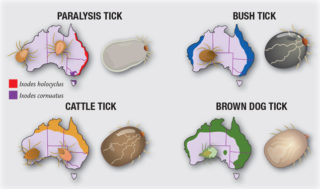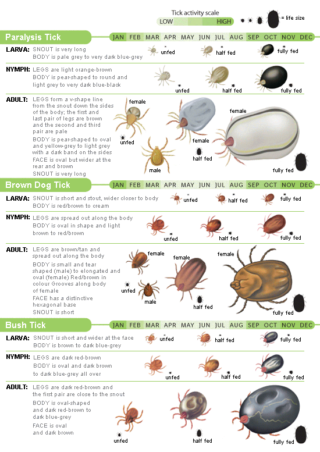When it comes to travelling, it’s all about looking for products that are convenient AND keep our pets safe. We’ve compared a few popular parasite treatments currently available, which have the best effect on our target parasites, to help you decide on which one suits your dog best.
Which parasites are a risk for my dog?
The most important parasites to cover whilst travelling are Heartworm and Paralysis Ticks, as they can be deadly and may not be part of your usual preventative regime if you don’t live in these areas. Brown dog ticks transmit the bacteria causing Ehrlichiosis, found in Western Australia, the Northern Territory and Queensland (see our article on Ehrlichia). Generally, all dogs should use a preventative for fleas and intestinal worms year-round regardless of location (roundworm, hookworm and Hydatid tapeworm can be passed to people). Hydatid tapeworm is a risk for dogs eating raw meat or offal, and Tasmania requires dogs to be treated before travel to our island state (see our article on Travel to Tasmania). Mites can be an occasional issue, whilst Sarcoptic mange is more likely if your dog is exploring areas with foxes and wombats and can also be passed to people.
How reliable are parasite preventative medications?
It is important to recognise that preventative products are not a guarantee, especially with parasites like the Paralysis Tick. All dogs travelling or living in a Tick area should be checked daily (at a minimum) for ticks – see our Tick Check Guide for further information. The majority of preventative treatments only kill the tick after it has attached, so the sooner a tick is removed the less chance there is of infections or other complications. In WA, the NT and now Queensland, Ehrlichia is transmitted from Brown Dog Ticks to dogs in a shorter time than spot-ons or chews can act, so the Seresto collar is recommended as it repels and kills ticks on contact before they can attach.
Ensuring that preventative treatments are repeated as recommended is imperative to their success. Monthly treatments must be given exactly monthly (within a 2-3 day window). We know that time flies and treatments can be easily forgotten when busy or travelling so choosing a longer term option may suit better in many circumstances for optimum health, convenience and peace of mind. Studies have shown the injectable heartworm treatment, Proheart SR12, to be the most effective heartworm preventative, both due to it’s ongoing long-term action as well as the susceptibility of heartworm to it’s active ingredient.
Likewise, choosing between an oral, spot-on, collar or injectable treatment depends on your dog’s lifestyle as well as the parasites being targeted. For example, if your dog loves swimming then a spot-on treatment is less likely to be as effective as an oral or injectable one (Seresto collars are waterproof so can, and should, be left on whilst swimming or bathing).
| Product | Bravecto spot-on | Bravecto chew | Nexguard Spectra chew | Simparica Trio chew | Seresto collar | Advantix spot-on | ProHeart SR12 injection | Milbemax tablet | Drontal chew |
| Heartworm | |||||||||
| Fleas | (5-6 months) |
(3 months) |
(8 months) |
||||||
| Paralysis Ticks | (5-6 months) |
(3-4 months) |
(4 months) |
||||||
| Brown Dog Ticks | (3 months) |
(2 months) |
(4 months) |
||||||
| Mosquitoes Sandflies Stableflies | (repels and kills) |
||||||||
| Lice | |||||||||
| Ear Mites | |||||||||
| Sarcoptes Mites | |||||||||
| Demodex Mites | |||||||||
| Roundworm | |||||||||
| Hookworm | (4 months) |
||||||||
| Whipworm | |||||||||
| Flea Tapeworm | (prevents by killing fleas, doesn’t treat current infection) |
(prevents by killing fleas, doesn’t treat current infection) |
(prevents by killing fleas, doesn’t treat current infection) |
||||||
| Other | (Hydatids) |
(Hydatids, Giardia) |
|||||||
| Approved for puppies from 8 weeks | (from 2kg) |
(from 2kg) |
(from 2kg) |
(from 1.25kg) |
(from 7 weeks) |
(from 7 weeks) |
(from 12 weeks) | (from 2 weeks / 0.5kg) |
(from 2 weeks) |
| Safe for breeding, pregnant and lactating dogs | (not evaluated) |
(not evaluated) |
(not established) |
||||||
| Recommended treatment interval | 5 months | 3 months | 1 month | 1 month | 4 months | 2 weeks (Paralysis Tick)
1 month |
1 year | 1 month (Heartworm / Hydatids)
3 months (GI worms) |
6 weeks (Hydatids)
3 months (GI worms) |
Are parasite preventative treatments safe?
You may have heard some concerns regarding some parasite treatments causing seizures. The isoxazoline class of treatments, which include the active ingredients in Bravecto, Nexguard Spectra and Simparica Trio, have been associated with neurologic adverse reactions including tremors, ataxia, and seizures in dogs with or without a history of neurologic disorders. These side effects have a very low incidence and the protection against Paralysis Tick is regarded as a higher benefit than this small risk (in other words, Paralysis Tick toxicosis causing possible death, or a minimum of very expensive treatment, is much worse than an unlikely seizure), but the manufacturers advise that these products should be used with caution in dogs with a history of seizures. All products don’t suit all pets, so please chat to your veterinarian about your dog’s individual risk factors.
So, what’s our personal opinion?
After looking at the research, results and safety data behind each product, along with the practicality of selecting the most convenient options that provide the most thorough possible protection against our target parasites whilst travelling, we like a combination approach. Our choice is to use a Bravecto chew and Milbemax/Drontal every 3 months, with a yearly injection of Proheart SR12, AND add a Seresto collar (every 4 months) if you’re travelling in WA or the NT due to the tick-borne disease Erhlichiosis (see our blog article on Ehrlichia for more information).
The other common option that covers all bases and is easy when travelling is Nexgard Spectra monthly with a tapewormer tablet every 3 months AND add a Seresto collar (every 4 months) if you’re travelling in WA or the NT due to the tick-borne disease Erhlichiosis (see our blog article on Ehrlichia for more information).
But, the bottom line is that the products that you ultimately use with your dog need to suit your individual dog and are your choice, so do your research and seek veterinary advice first. Dr Tania is happy to chat with you if you’d like to talk it through.
One of our responsibilities as travelling pet owners is that we don’t contribute to spreading diseases and vectors (like ticks, Ehrlichia or heartworm) further than their current endemic zone, so preventative actions are important not only for the health of your own pet but for all of us.
Want a discount on pet parasite prevention delivered to your door?
Head to www.obay.com.au and enter our unique code VIAV100R at the top left of the screen for an exclusive discount on all parasite preventatives and pet supplies.
Keep your chosen parasite preventatives handy by storing them in your Vet in a Van – Navigator Pet First Aid Kit
* Vet in a Van is in no way associated with or promoting any of these products, this comparison is based on information available from the respective manufacturers, product labels and personal experience, is intended to assist you in choosing a product that suits your dog and is not an exhaustive list of available options. Please discuss your dog’s individual requirements with your veterinarian and read the product label before starting a new product as underlying health issues and individual situations vary.









